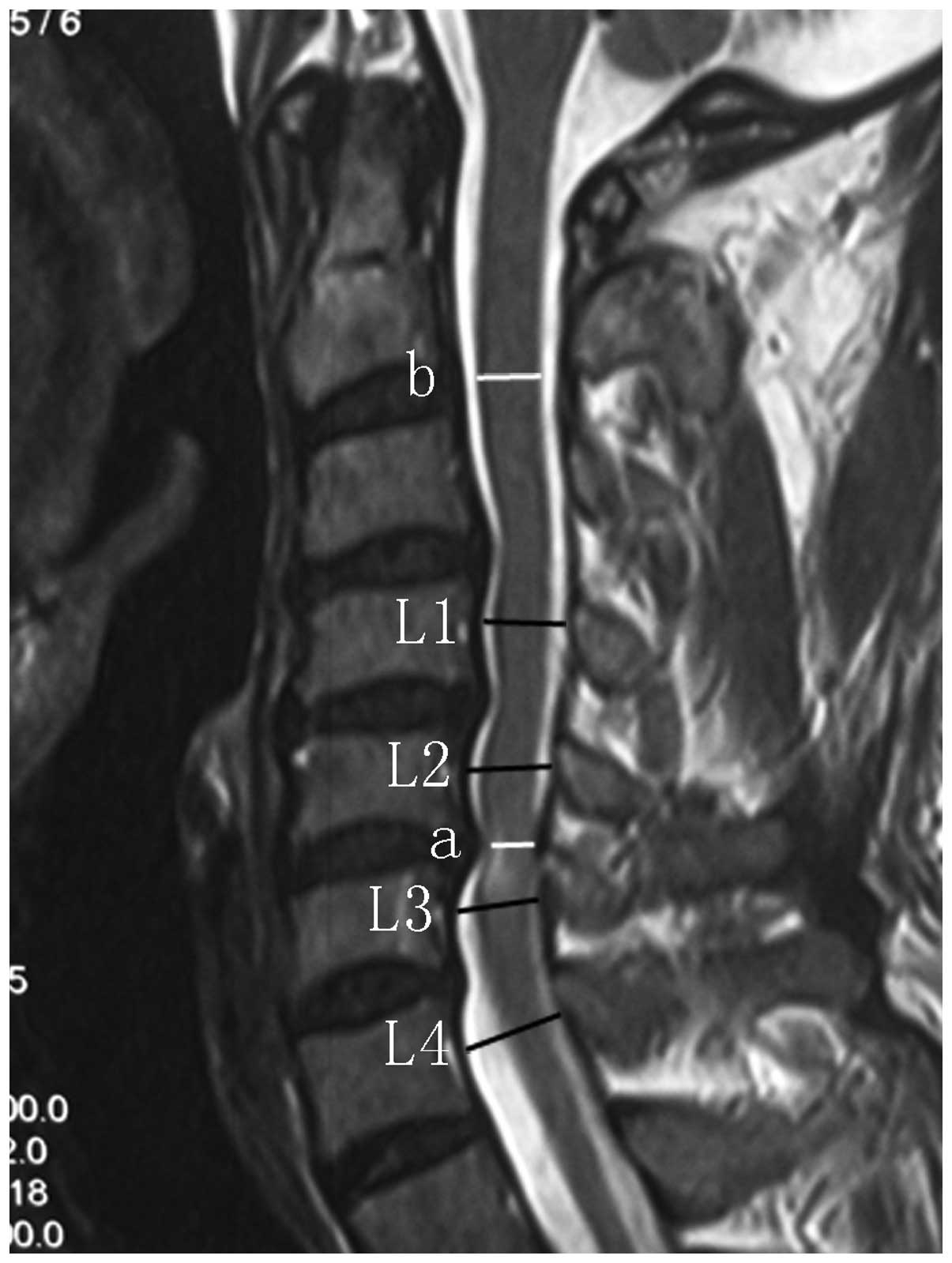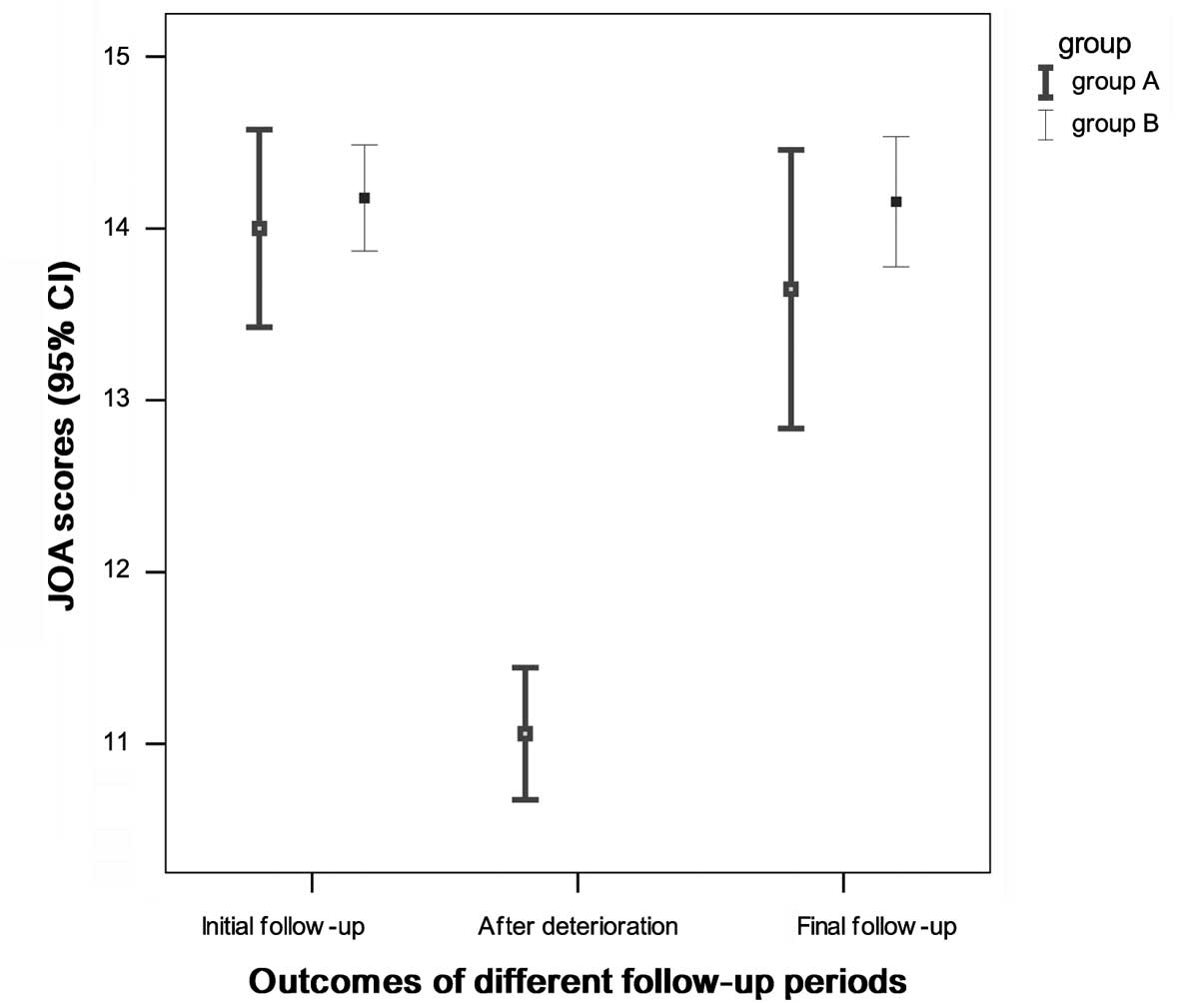|
1
|
Holly LT, Matz PG, Anderson PA, et al:
Clinical prognostic indicators of surgical outcome in cervical
spondylotic myelopathy. J Neurosurg Spine. 11:112–118. 2009.
View Article : Google Scholar : PubMed/NCBI
|
|
2
|
Koyanagi T, Hirabayashi K, Satomi K,
Toyama Y and Fujimura Y: Predictability of operative results of
cervical compression myelopathy based on preoperative computed
tomographic myelography. Spine (Phila Pa 1976). 18:1958–1963. 1993.
View Article : Google Scholar
|
|
3
|
Zhang P, Shen Y, Zhang YZ, Ding WY and
Wang LF: Significance of increased signal intensity on MRI in
prognosis after surgical intervention for cervical spondylotic
myelopathy. J Clin Neurosci. 18:1080–1083. 2011. View Article : Google Scholar : PubMed/NCBI
|
|
4
|
Acharya S, Srivastava A, Virmani S and
Tandon R: Resolution of physical signs and recovery in severe
cervical spondylotic myelopathy after cervical laminoplasty. Spine
(Phila Pa 1976). 35:E1083–E1087. 2010. View Article : Google Scholar : PubMed/NCBI
|
|
5
|
Cheung WY, Arvinte D, Wong YW, Luk KD and
Cheung KM: Neurological recovery after surgical decompression in
patients with cervical spondylotic myelopathy - a prospective
study. Int Orthop. 32:273–278. 2008. View Article : Google Scholar : PubMed/NCBI
|
|
6
|
Gok B, Sciubba DM, McLoughlin GS, et al:
Surgical treatment of cervical spondylotic myelopathy with anterior
compression: a review of 67 cases. J Neurosurg Spine. 9:152–157.
2008. View Article : Google Scholar : PubMed/NCBI
|
|
7
|
Oshima Y, Seichi A, Takeshita K, et al:
Natural course and prognostic factors in patients with mild
cervical spondylotic myelopathy with increased signal intensity on
T2-weighted magnetic resonance imaging. Spine (Phila Pa 1976).
37:1909–1913. 2012. View Article : Google Scholar
|
|
8
|
Sumi M, Miyamoto H, Suzuki T, Kaneyama S,
Kanatani T and Uno K: Prospective cohort study of mild cervical
spondylotic myelopathy without surgical treatment. J Neurosurg
Spine. 16:8–14. 2012. View Article : Google Scholar : PubMed/NCBI
|
|
9
|
Fouyas IP, Statham PF and Sandercock PA:
Cochrane review on the role of surgery in cervical spondylotic
radiculomyelopathy. Spine (Phila Pa 1976). 27:736–747. 2002.
View Article : Google Scholar : PubMed/NCBI
|
|
10
|
Kadaňka Z, Bednařík J, Novotný O, Urbánek
I and Dušek L: Cervical spondylotic myelopathy: conservative versus
surgical treatment after 10 years. Eur Spine J. 20:1533–1538.
2011.PubMed/NCBI
|
|
11
|
Kadanka Z, Mares M, Bednaník J, et al:
Approaches to spondylotic cervical myelopathy: conservative versus
surgical results in a 3-year follow-up study. Spine (Phila Pa
1976). 27:2205–2211. 2002.PubMed/NCBI
|
|
12
|
Angevine PD, Zivin JG and McCormick PC:
Cost-effectiveness of single-level anterior cervical discectomy and
fusion for cervical spondylosis. Spine (Phila Pa 1976).
30:1989–1997. 2005. View Article : Google Scholar : PubMed/NCBI
|
|
13
|
Fountas KN, Kapsalaki EZ, Nikolakakos LG,
et al: Anterior cervical discectomy and fusion associated
complications. Spine (Phila Pa 1976). 32:2310–2317. 2007.
View Article : Google Scholar : PubMed/NCBI
|
|
14
|
Shimomura T, Sumi M, Nishida K, et al:
Prognostic factors for deterioration of patients with cervical
spondylotic myelopathy after nonsurgical treatment. Spine (Phila Pa
1976). 32:2474–2479. 2007. View Article : Google Scholar : PubMed/NCBI
|
|
15
|
Yoshimatsu H, Nagata K, Goto H, et al:
Conservative treatment for cervical spondylotic myelopathy.
prediction of treatment effects by multivariate analysis. Spine J.
1:269–273. 2001. View Article : Google Scholar : PubMed/NCBI
|
|
16
|
Kadanka Z, Mares M, Bednarík J, et al:
Predictive factors for mild forms of spondylotic cervical
myelopathy treated conservatively or surgically. Eur J Neurol.
12:16–24. 2005. View Article : Google Scholar : PubMed/NCBI
|
|
17
|
Borden JN: Good Samaritan cervical
traction. Clin Orthop Relat Res. 113:162–163. 1975. View Article : Google Scholar : PubMed/NCBI
|
|
18
|
Kawasaki M, Tani T, Ushida T and Ishida K:
Anterolisthesis and retrolisthesis of the cervical spine in
cervical spondylotic myelopathy in the elderly. J Orthop Sci.
12:207–213. 2007. View Article : Google Scholar : PubMed/NCBI
|
|
19
|
Yamazaki T, Yanaka K, Sato H, Uemura K,
Tsukada A and Nose T: Cervical spondylotic myelopathy: surgical
results and factors affecting outcome with special reference to age
differences. Neurosurgery. 52:122–126. 2003.PubMed/NCBI
|
|
20
|
Naderi S, Ozgen S, Pamir MN, Ozek MM and
Erzen C: Cervical spondylotic myelopathy: surgical results and
factors affecting prognosis. Neurosurgery. 43:43–50. 1998.
View Article : Google Scholar : PubMed/NCBI
|
|
21
|
Suri A, Chabbra RP, Mehta VS, Gaikwad S
and Pandey RM: Effect of intramedullary signal changes on the
surgical outcome of patients with cervical spondylotic myelopathy.
Spine J. 3:33–45. 2003. View Article : Google Scholar : PubMed/NCBI
|
|
22
|
Fujiwara K, Yonenobu K, Ebara S, Yamashita
K and Ono K: The prognosis of surgery for cervical compression
myelopathy. An analysis of the factors involved. J Bone Joint Surg
Br. 71:393–398. 1989.PubMed/NCBI
|
|
23
|
Murone I: The importance of the sagittal
diameters of the cervical spinal canal in relation to spondylosis
and myelopathy. J Bone Joint Surg Br. 56:30–36. 1974.PubMed/NCBI
|
|
24
|
Edwards WC and LaRocca H: The
developmental segmental sagittal diameter of the cervical spinal
canal in patients with cervical spondylosis. Spine (Phila Pa 1976).
8:20–27. 1983. View Article : Google Scholar : PubMed/NCBI
|
|
25
|
Pavlov H, Torg JS, Robie B and Jahre C:
Cervical spinal stenosis: determination with vertebral body ratio
method. Radiology. 164:771–775. 1987. View Article : Google Scholar : PubMed/NCBI
|

















